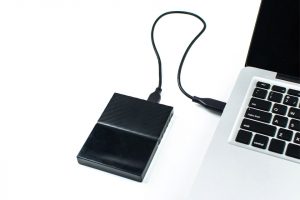Why Is My Exfat Drive Set to Read Only
There are plenty of annoying things that tin can happen while using your Macbook, i of which is plugging in a USB hard bulldoze and finding out that you cannot write to it, or copy to and from the external drive.
At that place isn't a single solution to all these woes, just here's a quick guide to addressing these bugbears that involve external hard drive functioning and connectedness to Mac.
File systems: An overview
A file system is a handy tool that allows an OS to read data on any USB drive or difficult drive. In that location are quite a few file systems out in that location, and the reality is that not every operating system works fine with each one of those systems.
Apple computers use HFS+ file system by default. Windows, on the other hand, uses New Technology File Organisation (NTFS).
Pro Tip: It's loftier time yous paid attending to online safety and security. Become a reliable VPN to hide your IP, protect your personal data from hackers, secure online transactions and use public Wi-Fi safely.
Special offer. Near Outbyte, uninstall instructions, EULA, Privacy Policy.

Mac users are likely to discover FAT32 and exFAT as their best options, and for a good reason. If yous've ever tried to format a hard bulldoze as NTFS, you have probably come across a handful of trouble in getting it to work with your Mac or Linux. macOS is able to recognize as well as read NTFS drives, merely information technology cannot write to them. NTFS works flawlessly with Windows, but leaves much to be desired with everything else.
Meanwhile, FAT32 and exFAT piece of work with all operating systems just fine. File Allocation Table (FAT) is the oldest of the file systems, hence it can exist recognized by every Os out there. Personal computers have seen its evolution from FAT12 to FAT16 to the electric current FAT32, and then the inflow of exFAT, created with USB drives and external drives in heed.
Your operating system'southward master hard drive should be the best lucifer for that Bone, while USB drives and external difficult drives should utilise either FAT32 or exFAT.
FAT32 vs. exFAT
Here are some points of comparison to assist y'all decide on which ane to go with:
- Devices supported – FAT32 is the most widely compatible file system, working on any Os too equally media players, devices, and video game consoles. exFAT, in contrast, will work fine on 99 percent of devices, but may encounter an issue on sure media players. Xbox One, for instance, usually runs into issues with exFAT USB drives formatted on a Mac.
- Sizes supported – FAT32 can support files with up to iv GB in size and can be used as the file system on hard drives that are eight TB at a maximum. exFAT, all the same, has no limitations on file sizes as well as hard bulldoze sizes, making it the better selection for those who are using a portable drive that stores massive files, such every bit 3D projects.
- Speed – Generally, exFAT drives are quicker at writing and reading data compared to FAT32 drives. As a rule of thumb, format your bulldoze as exFAT if you are fairly sure that you won't have a file smaller than four GB.
Y'all tin easily format a USB drive or external hard bulldoze as exFAT instead of FAT32. macOS users can follow these steps:
- Open up Spotlight (Command + Space). Run Disk Utility.
- Select the USB drive in the menu found on the left.
- Click Erase, and then choose exFAT in Format.
External hard drive 'read only' event? Here's a quick set up
In one case you plug in your drive and open Deejay Utility, highlight your drive in the sidebar and click Erase, as shown in the instructions to a higher place. Your adjacent step, however, can vary depending on what you want to practise with the blank drive:
- Portable drive – Are you not bad on making a portable drive to use with your Mac and Mac computers alone? Format your drive to HFS with the Mac Bone Extended choice.
- Time Machine backup – Are y'all using the drive to back up your Mac with Time Motorcar? Then format the drive to HFS+, which shows upward every bit Mac Bone Extended in the Disk Utility GIU.
- For older devices – In the off chance that you lot're using the deejay with another device that doesn't support for exFAT, then select the older FAT option. Commonly you should veer away from this option because information technology limits drive sizes to less than 32 GB.
Now, allow's get to a one-time prepare of enabling macOS built in experimental NTFS support. Take note: this method can have serious consequences and result in loss of information on target bulldoze, so skip this fix if you're writing to important volumes or eyeing a long-term solution.
This fix is based on the fact that sometimes we need to write some files to a drive in one case, in which case aught needs to exist installed. Mac has built-in support for reading NTFS by default, with the write capability hiding behind a Last hack.
Follow these steps:
- Open Terminal. In your editor of selection, open /etc/fstab. If yous have no preference, utilise Nano and type:
nano etc/fstab
- Copy this line into the file:
Label=DRIVENAME none ntfs rw,automobile,nobrowse
- Supersede DRIVENAME with the name of the drive yous'd like to access. Save the file by striking command+o, and then control+ten to quit Nano.
- Disconnect and reconnect your drive in order to remount it. Now it's available in /Volumes. Get hither via Finder: in the menu bar, click Go and cull Go to Folder. Enter /Volumes and then click Go.
fstab is a hidden file setting preferences for disks, and can exist useful for preventing deejay partitions from mounting. In this particular instance, it allows you to read-write on a deejay that is not writable on default.
If you're hardly comfortable with Terminal, you lot can choose a paid option for a pain-free mode of working with files. A paid selection likely entails less work and, equally we mentioned before, experimental back up isn't reliable in the long term.
Conclusion
To summarize, a Mac can read from an NTFS deejay, simply information technology cannot write to it without a fiddling work and help from 3rd-party NTFS software. You lot need to format the drive for use on a Mac.
exFat outperforms Fat32 in well-nigh aspects. NTFS is better in nigh all aspects compared to exFAT, but only if yous are using a USB drive on Windows computers. If you're a Mac user, NTFS isn't good news for you lot.
Once you've solved "read simply" external hard drive problems on your Mac, go into the habit of cleaning and optimizing your Mac for meridian performance using a reliable tool such every bit Mac repair app.
Mac users, tell united states of america about your own experience!

Source: https://softwaretested.com/mac/how-to-solve-the-read-only-external-hard-drive-problem-on-mac/
Enregistrer un commentaire for "Why Is My Exfat Drive Set to Read Only"